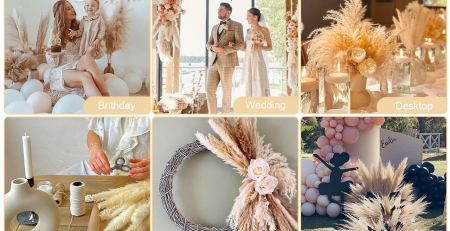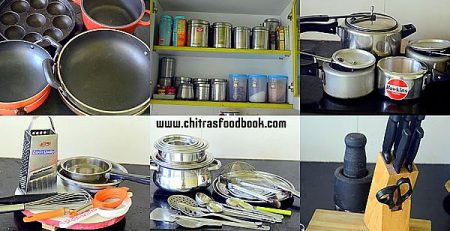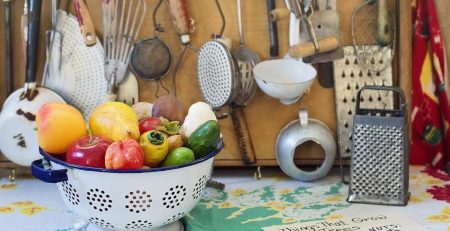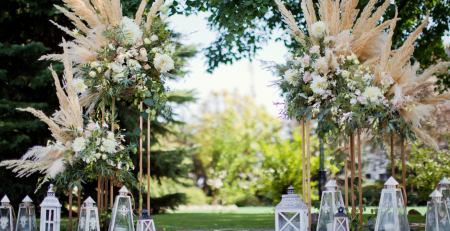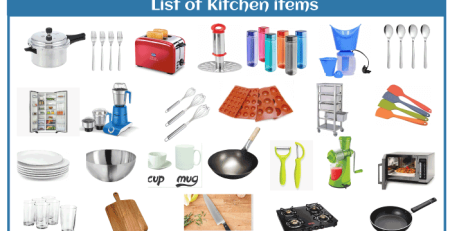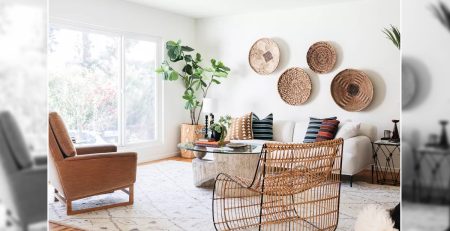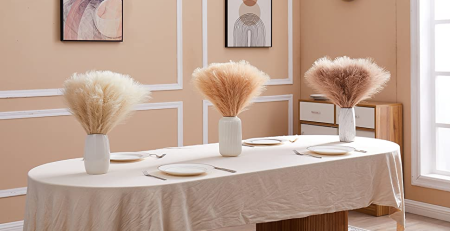What are the latest home decor trends?
Here are some of the latest home decor trends:
- Sustainability: More and more people are looking for environmentally friendly and sustainable decor options, such as organic textiles, repurposed and upcycled furniture, and zero-waste home goods.
- Nature-Inspired: Nature-inspired elements, such as botanical prints, wooden accents, and stone textures, are becoming increasingly popular in home decor.
- Bold Colors: Bright and bold colors, such as deep jewel tones and pastels, are making a big impact in home decor, adding drama and personality to any space.
- Textured Fabrics: Textured fabrics, such as boucle, velvet, and corduroy, are making a comeback in home decor, adding depth and texture to a space.
- Mid-Century Modern: The mid-century modern style is still going strong, with its clean lines, organic curves, and retro-inspired accents.
- Hygge: Hygge, the Danish concept of coziness and comfort, continues to influence home decor, with people seeking to create warm and inviting spaces in their homes.
- Technology Integration: The integration of technology into home decor is becoming more prevalent, with smart home systems and digital devices becoming increasingly common in modern homes.
- Minimalism: Minimalist decor is still popular, with people seeking a clean and uncluttered aesthetic in their homes.
These are just some of the current home decor trends, and they are constantly evolving and changing. It’s important to find what resonates with you and what suits your personal style, rather than blindly following trends.
Here are some ways that people are incorporating sustainability into their home decor:
Sustainability is a growing trend in home decor and one that is becoming increasingly important to many people. The idea behind sustainability in home decor is to reduce the environmental impact of our daily lives and create a greener, cleaner, and more responsible world.
- Eco-Friendly Textiles: Using organic cotton, bamboo, and linen instead of synthetic materials can help reduce the environmental impact of home decor.
- Upcycled Furniture: Repurposing old furniture and giving it new life can help reduce waste and save resources.
- Zero-Waste Home Goods: Choosing products that are packaged in minimal or biodegradable materials can help reduce waste and promote sustainability.
- LED Lighting: LED lighting is energy-efficient and has a longer lifespan than traditional lighting, making it a great choice for a sustainable home.
- Reclaimed Materials: Using reclaimed materials, such as wood from old buildings or metal from scrapped cars, can reduce the need for new resources and help conserve the environment.
- Green Plants: Plants not only add life and beauty to a space, but they also help improve air quality and purify the air.
Incorporating sustainable elements into your home decor can be as simple or complex as you like, but even small changes can make a big impact. By choosing eco-friendly options, you can help create a more sustainable world, one room at a time.
Nature-inspired home decor
Nature-inspired home decor is a popular trend that is all about bringing the beauty of the outdoors into the home. It’s a way to incorporate natural elements such as wood, stone, and plants into your decor to create a calming and serene environment.
Here are some ways to incorporate nature-inspired decor into your home:
- Wood Accents: Wood is a classic material for home decor, and it’s a great way to bring nature inside. You can use natural or reclaimed wood for furniture, flooring, or even as a decorative accent.
- Stone Elements: Stone is another natural material that can be used to add texture and character to your decor. Consider using stone tiles, countertops, or even a stone accent wall.
- Houseplants: Plants are an essential part of nature-inspired decor. They not only look great but also help purify the air and create a more natural atmosphere.
- Natural Textiles: Textiles made from natural fibers, such as cotton, linen, or wool, can add a touch of nature to your decor. You can use these materials for curtains, bedding, or even throw pillows.
- Natural Light: Maximizing natural light is another way to bring nature into your home. Large windows, skylights, and light-colored walls can help brighten up your space and create a more natural atmosphere.
- Nature-Inspired Art: Art can be a great way to bring nature into your home. Consider adding wall art or sculptures that depict natural scenes or wildlife.
Incorporating nature-inspired elements into your home decor can help create a peaceful and calming environment that is in tune with the natural world. By using natural materials and incorporating natural light, you can create a space that is both beautiful and eco-friendly.
Bold colors are a popular trend in home decor
Bold colors are a popular trend in home decor and are a great way to add energy and excitement to any space. Using bold colors can help create a statement and make a room feel more lively and dynamic.
Here are some ways to incorporate bold colors into your home decor:
- Accent Walls: An accent wall is a great way to add bold color to a room. Consider painting a single wall in a bright color, or use a bold wallpaper to create a statement.
- Furniture Pieces: Furniture pieces in bold colors, such as a red sofa or a blue armchair, can be a great way to add color to a room.
- Accessories: Accessories such as throw pillows, rugs, and curtains can be a great way to add bold color to a room. You can also use brightly colored vases, bowls, or lamps to add pops of color.
- Artwork: Artwork is another way to add bold color to a room. Consider adding large abstract paintings, brightly colored prints, or bold graphic artwork to create a statement.
- Flooring: Flooring can also be a great way to add bold color to a room. Consider using a brightly colored area rug or patterned tile to create a statement.
When incorporating bold colors into your home decor, it’s important to balance them with neutral elements, such as white walls or neutral-colored furniture. This will help create a harmonious and cohesive look in your space.
Bold colors can be a great way to add personality and energy to your home decor. Whether you choose to use bold color in small accents or in larger statement pieces, it can be a fun and playful way to make your space feel unique and vibrant.
Textured fabrics are a popular trend in home decor
Textured fabrics are a popular trend in home decor and can add depth and interest to any space. By incorporating different textures, you can create a warm and inviting atmosphere in your home.
Here are some ways to incorporate textured fabrics into your home decor:
- Upholstery: Upholstered furniture, such as sofas, chairs, and ottomans, can be a great way to add texture to a room. Consider using a variety of fabrics, such as velvet, linen, or suede, to create interest.
- Bedding: Textured bedding, such as a fluffy comforter or a woven duvet cover, can add warmth and coziness to your bedroom.
- Curtains: Curtains can be a great way to add texture to a room. Consider using textured fabrics, such as burlap or jute, to create a natural and organic feel.
- Area Rugs: Area rugs are another way to add texture to a room. Consider using rugs made of natural fibers, such as sisal or jute, to create a warm and cozy feel.
- Pillows: Throw pillows are a great way to add texture to a room. Consider using a variety of textures, such as velvet, cable knit, or faux fur, to create interest.
When incorporating textured fabrics into your home decor, it’s important to balance them with smooth and neutral elements, such as smooth metal or glass, to create a harmonious look.
Textured fabrics can bring warmth and comfort to your home, and can help create a cozy and inviting atmosphere in any room. Whether you choose to incorporate textured fabrics into your upholstery, bedding, curtains, or accessories, it’s a great way to add depth and interest to your home decor.
Mid-Century Modern
Mid-Century Modern: Mid-Century Modern is a popular trend in home decor that is characterized by clean lines, organic shapes, and a focus on functionality. This style is inspired by the design of the 1950s and 1960s and incorporates elements such as tapered furniture legs, geometric patterns, and natural materials like wood and leather.
Mid-Century Modern is a popular style in home decor that is inspired by the design of the 1950s and 1960s. This style is characterized by clean lines, organic shapes, and a focus on functionality. Mid-Century Modern design often incorporates elements such as tapered furniture legs, geometric patterns, and natural materials like wood and leather.
In a Mid-Century Modern-inspired home, furniture is often the focal point, and key pieces like armchairs, sofas, and coffee tables are chosen for their sleek lines and unique shapes. Bold colors and graphic patterns are also commonly used in Mid-Century Modern decor, but are balanced with neutral elements like white walls, natural woods, and neutral textiles to create a harmonious and balanced space.
Mid-Century Modern design is known for being both functional and stylish, and it continues to be a popular trend in home decor. Whether you are looking to create a retro-inspired space or simply want to incorporate elements of this style into your home, there are many ways to embrace Mid-Century Modern and bring a touch of this timeless style into your home.
Hygge home decor
Hygge is a Danish concept that emphasizes comfort, coziness, and contentment. This style is characterized by warm and inviting spaces, soft lighting, and a focus on comfort. To create a Hygge-inspired home, consider adding cozy textiles like blankets and throw pillows, using warm lighting like candles or lamps, and incorporating natural elements like wood and greenery.
Hygge (pronounced “hoo-ga”) is a Danish concept that has recently gained popularity in home decor and interior design. Hygge is all about creating a warm, cozy, and comfortable atmosphere in your home, and it is centered around the idea of embracing simple pleasures and promoting a sense of well-being.
In terms of home decor, Hygge is characterized by the use of warm and soft materials, such as wool, cashmere, and natural woods. Candles, blankets, and soft lighting are also key elements of the Hygge aesthetic, and are used to create a warm and inviting ambiance in a space.
Incorporating Hygge into your home can be as simple as adding some soft textiles and lighting, or it can be a more extensive project that involves redecorating a room or even your entire home. Regardless of the approach you take, the goal of Hygge is to create a space that is comfortable, cozy, and welcoming.
Whether you are looking to create a space that is truly hygge or simply want to incorporate elements of this concept into your home decor, there are many ways to do so. From using natural materials to incorporating soft lighting and textures, there are many ways to create a warm and cozy atmosphere in your home that promotes a sense of well-being and comfort.
Technology Integration for home decoration:
Technology Integration: Technology integration is becoming increasingly popular in home decor as technology becomes more integrated into our daily lives. This trend incorporates technology into the home in ways that enhance the overall design and functionality of a space. This can include things like smart home systems, home theaters, and even smart furniture.
Technology Integration in Home Decor:
- Smart Home Systems: Incorporating technology like smart home systems, which allow you to control your lights, thermostats, and other home appliances with a touch of a button, can make your home more convenient and efficient.
- Home Entertainment Systems: Investing in a high-quality home entertainment system, complete with a large screen TV, sound system, and other multimedia components, can create a more immersive and enjoyable entertainment experience.
- Home Automation: Home automation systems, such as lighting control systems and automated blinds, can help to make your home more comfortable and energy-efficient.
- Wireless Charging: Integrating wireless charging into your home decor can provide a convenient and seamless way to charge your devices without the need for cords and plugs.
- Home Security Systems: Installing a home security system, complete with cameras, motion sensors, and alarm systems, can help to keep your home and family safe and secure.
- Virtual Assistants: Using virtual assistants like Amazon’s Alexa or Google Home can allow you to control your home, play music, and even make phone calls, all with voice commands.
- Energy Management Systems: Installing an energy management system can help you to monitor and control your home’s energy usage, helping to save money on your energy bill and reduce your carbon footprint.
Minimalism for home decor
Minimalism: Minimalism is a trend that emphasizes simplicity and functionality. This style is characterized by clean lines, neutral colors, and a focus on functionality. To create a minimalist home, consider incorporating simple and clean-lined furniture, neutral colors, and a focus on functionality. By keeping things simple and streamlined, you can create a space that is both functional and aesthetically pleasing.
Minimalism in Home Decor:
- Neutral Colors: Minimalist home decor often features neutral colors such as white, black, gray, and beige, which create a calming and serene atmosphere.
- Simple Designs: Minimalism is characterized by simple, clean lines and understated designs. This can be seen in the use of unadorned furniture, as well as a focus on functionality over form.
- Decluttering: A key aspect of minimalist home decor is decluttering, getting rid of excess items and only keeping what is necessary.
- Natural Materials: Natural materials like wood, stone, and cotton are often favored in minimalist home decor, as they bring a sense of warmth and grounding to the space.
- Open Space: Minimalist homes often feature open spaces, with a focus on creating a flow and sense of spaciousness.
- Limited Decor: Instead of filling the home with decorative items, minimalist homes typically have limited decor, with only a few key pieces that are chosen for their functionality and aesthetic appeal.
- Focus on Functionality: Minimalism prioritizes functionality over form, with an emphasis on creating a space that is practical, easy to use, and comfortable.
- Soothing Atmosphere: By keeping things simple and uncluttered, minimalist home decor creates a soothing atmosphere that is conducive to relaxation and stress relief.



